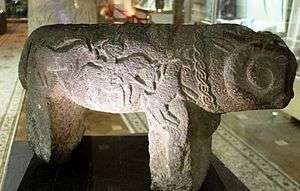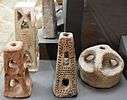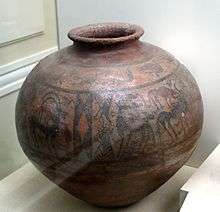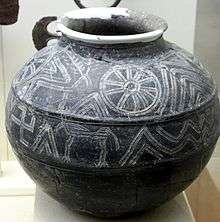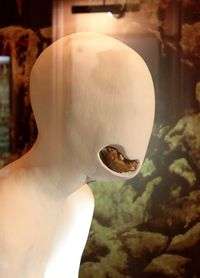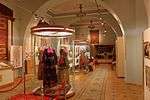National Museum of History of Azerbaijan
The National Museum of History of Azerbaijan (Azerbaijani: Milli Azərbaycan Tarixi Muzeyi) is the largest museum in Azerbaijan, located in Baku, in the former mansion of Azerbaijani oil magnate and philanthropist Haji Zeynalabdin Taghiyev. It was founded in 1920 and opened to visitors in 1921.[1]
Milli Azərbaycan Tarixi Muzeyi | |
Museum of History of Azerbaijan | |
| Established | 1920 |
|---|---|
| Location | H. Z. Taghiyev Street 4, Baku, |
| Type | History museum |
| Collection size | Archeological, Numismatic, Ethnographic |
| Director | Naile Velihanly |
| Public transit access | M 1 Sahil metro station |
| Website | www.azhistorymuseum.az |
History
The building of the Museum was built in 1893–1902. The Italian Renaissance-style mansion is immense and takes up an entire city block. There are four floors in some parts of the building. It was designed by Polish architect Józef Gosławski.
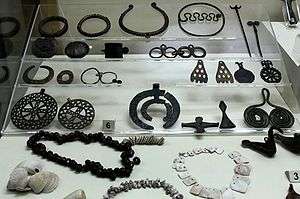
When the Red Army entered Baku in April 1920, Taghiyev's residence – like that of other wealthy oil barons – was immediately confiscated. Under a resolution of the USSR People's Commissariat, the residence was established as a museum in June 1920, only two months after the Bolsheviks took Baku.
In May 1934, a special order was adopted to improve the teaching of history and geography in schools, or, more precisely, to inculcate the ‘advantages’ of socialist society in its members in order to nurture the rising generation in the ideology of the totalitarian regime.[2] Marxist understanding of history was delivered through the establishments of historical research and other institutions. In addition, new kinds of historical and regional museums were created to inspire the teaching and promotion of history.
The network of museums with a historical profile was enlarged in regard with the new system. Furthermore, mechanisms of Soviet advocacy became much stronger and mouthpieces during this period. Moreover, the knowledge of the history of our native land was developed through the museum’s achievements in research. In this fashion, phrases like “the first” and “for the first time” are often used when conversation turns to its ninety years of work. From 1925 to the 1960s, until the Institute of History of the Academy of Sciences was made responsible for archaeological work, the foundations for the scientific investigation of ancient material and cultural monuments on the territory of Azerbaijan were laid under the direction of archaeologists Davud Sharifov, Yevgeniy Pakhomov, Ishak Jafar-Zadeh, Movsum Salamov, Saleh Gaziyev, Mammadali Huseynov.[2] Excavations were carried out in Khojaly, Qabala, Ganja, Kharaba Gilan, Orangala, Mingechevir and other places. Museum’s collection consists of the materials discovered during these excavations and from ethnographic expeditions. Undoubtedly, museum’s collection allows enriching data for a great many books and theses.
Architecture
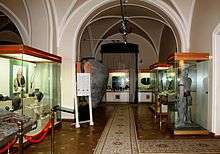
On the second floor of Taghiyev's residence, side by side there are two major ballrooms. One is based on Oriental designs (Mauritanian) style and the other, on Occidental design. The Oriental Room has enormous plate glass windows, gilded arches, highly ornamental walls, ceilings and chandeliers. The lines in the Occidental Room are more perpendicular to each other – rectangular.
According to photographs that are about 90 years old, one of the most elaborate rooms was Taghiyev's wife's boudoir (private sitting room). All of the movable furniture and paintings in this room have disappeared. Nothing remains today except the ornate mirrored mosaic ceiling. During the Soviet period, four layers of white paint were applied over the highly decorative floral designs on the walls. Still in the main halls of the residence, the original paint has withstood the passage of time incredibly well. The paint was made of finely ground egg shell as was the practice of artists of Byzantine icons. Nearly 100 years later, the original colors with their subtlety and sophistication have neither faded nor chipped.[3]
Departments
The museum has more than 2000 exhibits and includes the following departments:[4]
- Modern history department
- Ethnography department
- Department of ancient and medieval history of Azerbaijan
- Scientific excursion department
- Laboratory for restoration of museum exhibits
- Fund of Numismatics: Including the collection of Yevgeni Pakhomov
- Art design group
- Library
Address
4 Hadji Zeynalabdin Taghiyev str., Baku, 1005 (near “Sahil” metro station).
Gallery
Numismatic collection
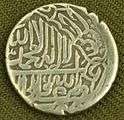 Safavid Abbas I. Silver coin, 1587.
Safavid Abbas I. Silver coin, 1587.
 Shah Ismail Khatai the Safavid. Silver coin, 1507.
Shah Ismail Khatai the Safavid. Silver coin, 1507.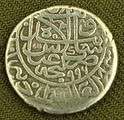 Safavid Abbas I. Silver coin, 1587.
Safavid Abbas I. Silver coin, 1587.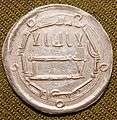
 Safavids, Shah Abbas II the Safavid, silver coin, 1647.
Safavids, Shah Abbas II the Safavid, silver coin, 1647.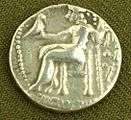
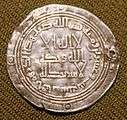 Amavid dynasty, silver dirham, Derbent.
Amavid dynasty, silver dirham, Derbent.
.jpg)
See also
- List of museums in Azerbaijan
- Ganja State History-Ethnography Museum
- Zeynalabdin Taghiyev
References
- "Azerbaijan National Committee of International Council of Museums (ICOM)". Archived from the original on 3 November 2008. Retrieved 17 November 2008.
- "Visions of Azerbaijan Magazine ::: The National Museum of Azerbaijani History at 90". Visions of Azerbaijan Magazine (in Russian). Retrieved 17 May 2017.
- National History Museum: Taghiyev's Residence Azerbaijan International Magazine
- Azerbaijan National Academy of Sciences Archived 25 September 2004 at the Wayback Machine
External links
| Wikimedia Commons has media related to National Museum of History of Azerbaijan. |
- Official website (in Azerbaijani and English)

